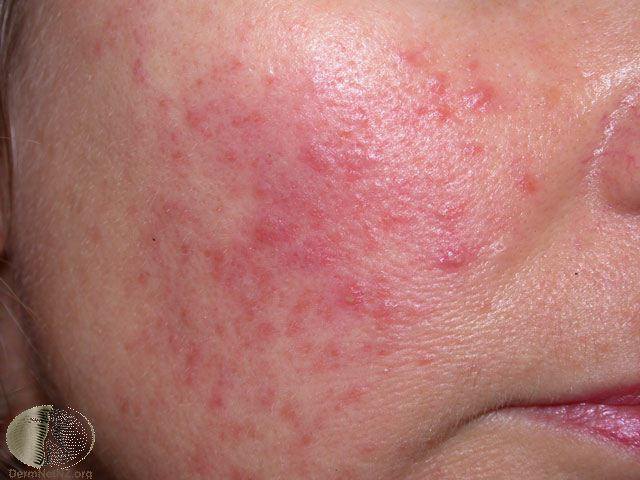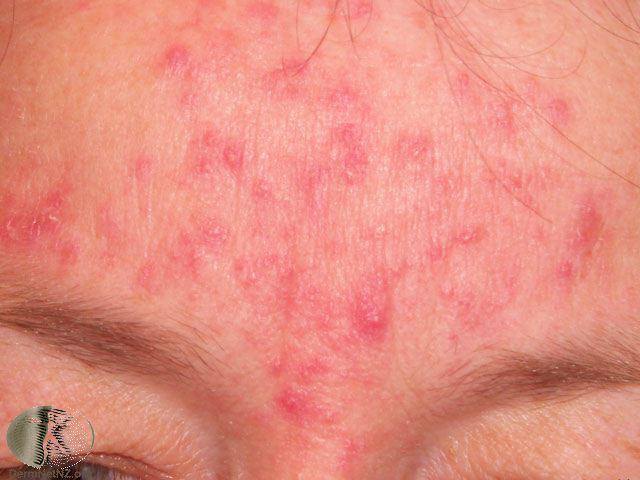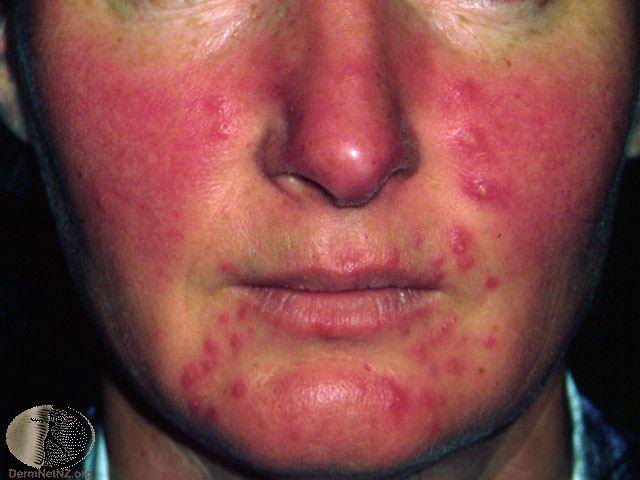This article is part of the Rosacea Theory Universe series.
Some have reported improvement in the redness and inflammation of subtype 1 when using a subtype 2 treatment. Rosacea is a concomitant disorder and solutions are not necessarily neatly categorized into subtypes.
Examples of Subtype 2

Mild papules and redness

Moderate papules, pustules, and redness

Severe papules, pustules, and redness
Kill the Bacteria
Bacterial infection and SIBO (small intestine bacterial overgrowth) have often been associated with rosacea1. For some patients, rosacea lesions are significantly improved or eradicated with antibacterial treatment. However, aggressive antibiotic treatment can desotry all good bacteria in the gut which can lead to long-term digestive problems.
Prescription Antibiotics
Oral Versions
I don’t recommend oral prescription antibiotics for rosacea unless you are willing to go through an aggressive protocol with a physician who specializes in SIBO and post-SIBO care. The use of multiple weaker antibiotics such as tetracycline and oral metronidazole rarely cure rosacea but can produce antibiotic resistance and a damaged gut.
For the stronger protocols, rifaximin is the traditional SIBO treatment of choice. In some cases, triple antibiotic therapy is used, one example being clindamyacin, metronidazole, and neomycin.
Topical Versions
If you (or your dermatologist) are determined to try antibiotics, then use a topical antibiotic over an oral version. A topical antibiotic will not damage your digestive system and is far less likely to cause resistance. The most common topical antibiotics are clindamycin and metronidazole creams.
Herbal Antibiotics
An interesting study was done showing that herbal therapy for SIBO was equivalent to prescription rifaximin treatment2. The study participants were treated with preparations of multiple herbs listed below. If you intend to undergo herbal therapy, you may need to combine several natural antibiotics to achieve the same strength as a prescription.
Oral Versions
Berberine
An extremely potent herbal antibiotic that also inhibits bacteria biofilms3, berberine has a few side effects you should be aware of. Berberine lowers blood sugar and should not be combined with medications for type 2 diabetes such as Metformin. Stomach cramps and nausea have also been reported as a side effect of high doses of berberine—split your dose two or three times a day to avoid this. Lastly, berberine can interact negatively with prescription macrolide antibiotics such as azithromycin and clarithromycin. The berberine dosage to lower blood sugar is around 1500mg a day; your usage may vary for rosacea treatment.
Guduchi
An Aruyvedic herb, guduchi has shown antimicrobial activity against several strains of bacteria4. It has also been traditionally used for psoriasis and eczema. It can be constipating to those who are prone to sluggish bowels.
Horsetail
The above-ground parts of the horsetail plant, such as the stem, have been shown to have a broad spectrum of very strong antimicrobial activity5. Horsetail is most commonly taken in a bitter tincture which is usually more concentrated than capsules.
- Hawaii Pharm Horsetail Tincture
- Nature’s Answer Horsetail Tincture
- Nature & Plantes Horsetail Capsules 570mg
- Solaray Horsetail Capsules 400mg
Lemon Balm
Lemon Balm is part of the mint family and exhibits antibacterial6 and antiviral7 activity due to caffeic acid, tannis, dimeric derivatives, and trimeric derivatives.
- Oregon’s Wild Harvest Lemon Balm Capsules 1125mg
- Solaray Lemon Balm Capsules 500mg
- Traditional Medicinals Lemon Balm Tea
Oregano Oil
Another member of the mint family, the natural antibiotic oregano oil8 contains thymol and caravacrol both of which show antibacterial activity. Oregano oil should be ingested in softgels. The manufacturer should list the amount of carvacrol and thymol contained in each dose. If those ingredients are not listed then most likely the product does not contain either and will be ineffective.
- Gaia Herbs Oregano Oil Softgels 230mg (32mg carvacrol and thymol)
- Gold Source Labs Wild Oregano Oil Softgels 45mg (32mg of carvacrol)
- Zane Hellas Oregano Oil Softgels 500mg (64mg of carvacrol)
Topical Versions
Lemon Balm
Lemon Balm is part of the mint family and exhibits antibacterial6 and antiviral7 activity due to caffeic acid, tannis, dimeric derivatives, and trimeric derivatives. Lemon balm salve or diluted lemon essential oil can be used a treatment for infected skin.
- Urban ReLeaf Lemon Balm Salve
- WiseWays Lemon Balm Salve
- Majestic Pure Cold-Pressed Lemon Essential Oil
Tea Tree
One of the oldest used topical antibacterials, tea tree oil and derived products are easily obtainable. For the maximum antibacterial activity, I recommend getting 100% tea tree oil and diluting it yourself in your favorite cleanser or moisturizer.
One such product is tea tree oil (TTO), the volatile essential oil derived mainly from the Australian native plant Melaleuca alternifolia. Employed largely for its antimicrobial properties, TTO is incorporated as the active ingredient in many topical formulations used to treat cutaneous infections9.
- Maple Holistics Tea Tree Oil
- Radha Tea Tree Oil
- Dr. Woods Tea Tree Facial Cleanser
- Era Organics Tea Tree Oil Rosacea Cleanser
- Desert Essence Tea Tree Oil Skin Ointment
- Era Organics Tea Tree Oil Face Cream
Light Treatments
Bacteria is vulnerable to certain wavelengths of blue light. Formerly only offered in dermatology offices, blue light treatments are now available in the comfort of your own home. Although an at-home unit is a little pricey, it is far less expensive than regular treatments at the doctor’s office..
Because rosacea tends to be so widespread across the face, I do not recommend spot treatment units. Look for a unit that covers your whole face or a large area of the face at one time.
- LightStim for Acne
- Neutrogena Light Therapy Acne Mask
- Norlanya Photon Therapy
- Trophy Skin BlueMD Light Therapy
Kill the Mites
The role of mites in rosacea has recently been studied and confirmed by the general medical community. Demodex mites are commonly found in the skin of most humans in the world. Demodex brevis live in the sebaceous glands. Demodex folliculorum live in the hair follicles and eyelid glands. Although “normal skinned” people will never notice demodex mites, rosaceans seem to have either an overabundance of mites10 or an overreaction to their activity.
Part of the problem may still be bacterial. Demodex folliculorum are linked to a bacterium called Bacillus oleronius. The best antibiotics for rosacea tend to be those that attack Bacillus oleronius11 which leads us back to the mites as a culprit.
Many rosaceans plagued with papules and pustules have seen great success with anti-mite treatments, so it’s definitely worth a shot. But be prepared to exert a lot of patience and perseverance. The mites have a long growth cycle and the treatments generally kill the adults but don’t kill the eggs—so you’re looking at several months to kill them all as new litters of mites hatch.
Demodex mites are also particularly good at burrowing down into the skin where topicals can’t quite reach. The best time to use a demodex treatment is at night. This isn’t black magic–demodex mites only emerge in the dark12.
Ivermectin (Soolantra)
The use of ivermectin for rosacea increased dramatically once a major medical pharmaceutical company created a prescription cream called Soolantra. However rosaceans around the world had been using ivermectin long before Soolantra came onto the scene. Soolantra can cost you anywhere from $80 to $300 a tube depending your insurance coverage or lack of.
If you’d rather not sell your house to afford a tiny tube of mite cream, try the ivermectin first. I have personally used both, yet achieved identical results using generic ivermectin fluid manufactured for farm animals. You can use a paste or an “injection fluid” and safely apply it to your skin. I find the injection fluids to generally be clear and invisible on the skin, while the cheaper paste can be a bit nasty to apply.
- Duramectin Ivermectin Paste
- Horse Health Ivermectin Paste
- Agri-mectin Generic Ivermectin Injection
- Ivermax Ivermectin
- Ivomec Injectable Ivermectin
- Vetrimec Ivermectin
Permethrin
An older prescription cream that also kills demodex13, permethrin has largely been overshadowed by costly Soolantra. I once read a study that stated permethrin cream killed adult mites and mite eggs, while ivermectin only killed adult mites. I can’t find that study again for the life of me—but if I’m remembering correctly, that would make permethrin a superior treatment.
Tea Tree Oil
In one study, demodex count went to zero in 7 out of 9 patients after 4 weeks of using a solution of 50% tea tree oil14. It was also shown that demodex is killed in 15 minutes of 100% tea tree oil in a test tube. The in vivo study actually treated ocular rosacea using a tea tree oil eyelid scrub, so it is possible that more persistent or intense treatment is needed for the face. Slightly diluted tea tree oil or a cream left on for at least 15 minutes (more ideally overnight) will be more effective than a cleanser.
- Maple Holistics Tea Tree Oil
- Radha Tea Tree Oil
- Dr. Woods Tea Tree Facial Cleanser
- Era Organics Tea Tree Oil Rosacea Cleanser
- Desert Essence Tea Tree Oil Skin Ointment
- Era Organics Tea Tree Oil Face Cream
Sulfur and Zinc Oxide
Sulfur or zinc oxide may be able to kill mites by suffocating them15. Use a thick cream all over the face and make sure to cover the eyelids and the base of the eyelashes where demodex mites like to hide. Leave the cream on overnight for several months. Zinc oxide is relatively inert and can be used for as long as you like. Sulfur cream is drying and sloughs away skin cells, so you would need to rotate it with zinc oxide to prevent over exfoliating and irritating the face. The sulfur cream should be at least 10% sulfur, but more sulfur is not necessarily better at mite killing. It is more important that the cream is applied in a very thick layer over the entire face to suffocate the mites. Only use higher sulfur content if you want a stronger exfoliating effect.
- BIOAA 33% Sulfur Ointment
- Mite-B-Gone 10% Sulfur Cream
- NuSkit 10% Sulfur Ointment
- San Marcos 10% Sulfur Ointment
- Scabisil Topical 10% Sulfur Ointment
- Dynarex Corporation Zinc Oxide Jar
- Rugby Zinc Oxide Ointment USP
- Selan+ Zinc Oxide Barrier Cream




